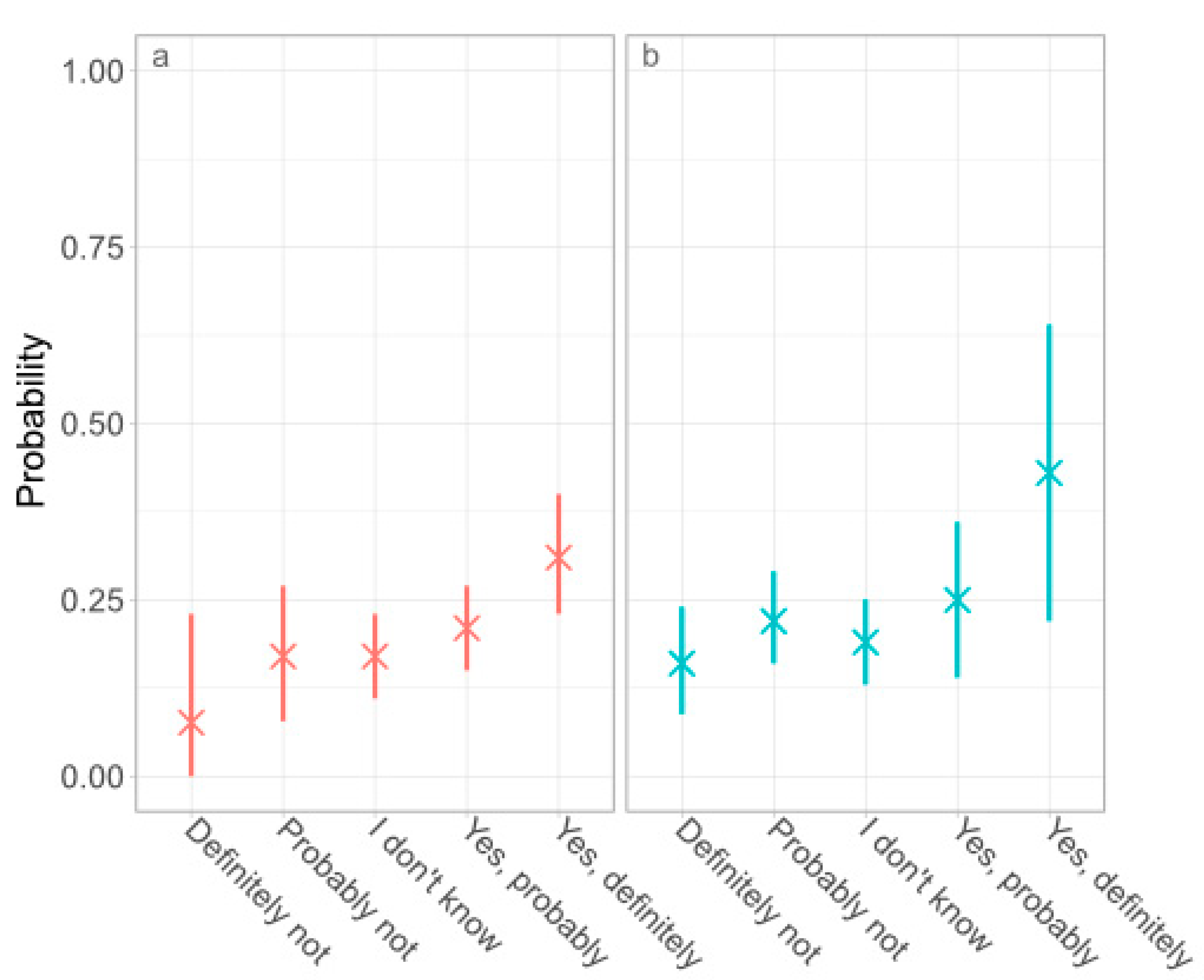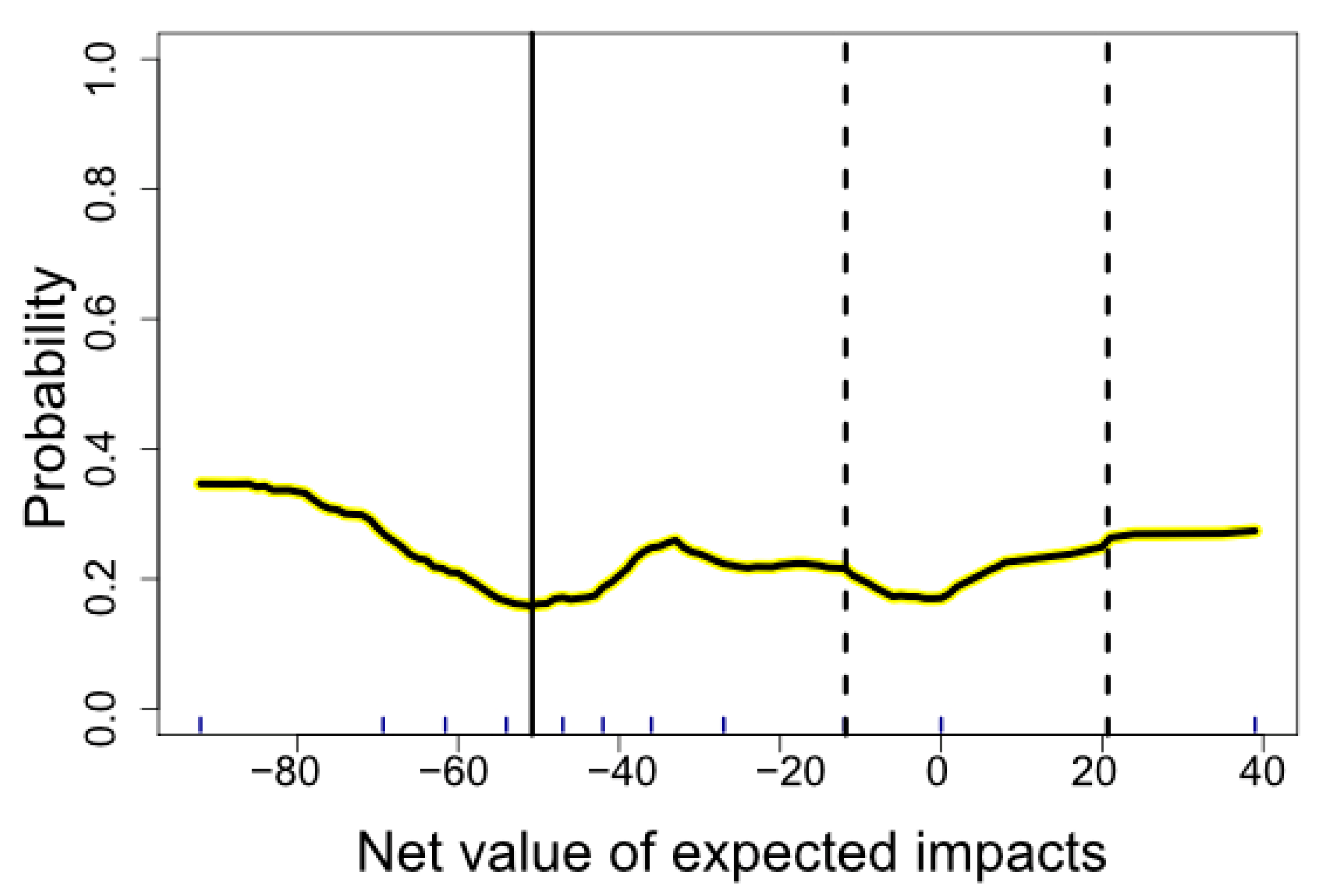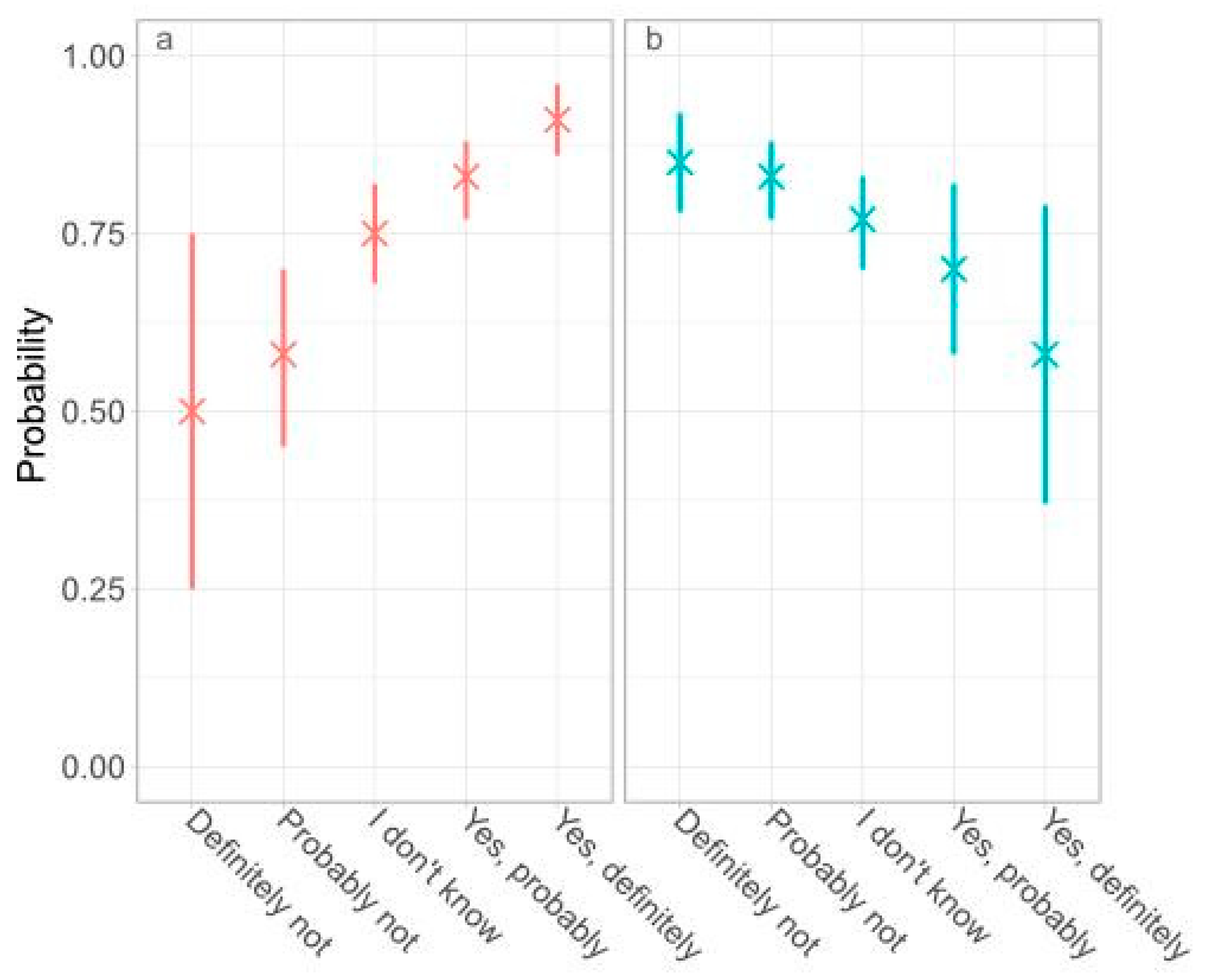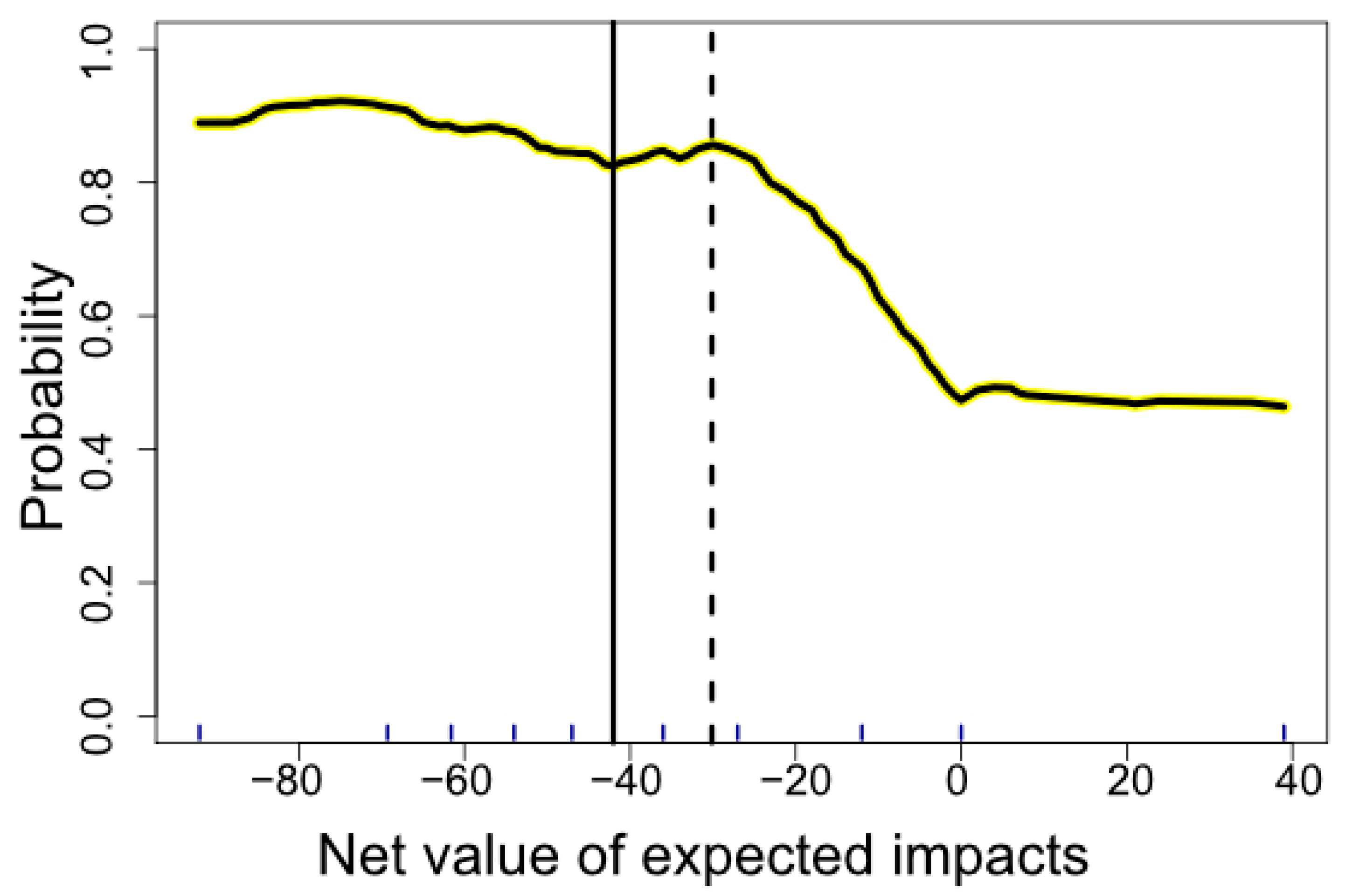To Mitigate or Adapt? Explaining Why Citizens Responding to Climate Change Favour the Former
Abstract
1. Introduction
2. Materials and Methods
2.1. Data
2.2. Statistical Analysis and Machine Learning Modelling
3. Results
3.1. H1: Motivation for Personal Decisions Because They Favour of Adaptation to the Impacts of Climate the Change Correlates with the Decision-Making Agent´s Knowledge of Specific Local Impacts of Climate Change
3.2. H2: Motivation for Personal Decisions Because They Favour Mitigation of Climate Change Correlates with the Risk Perception of the Decision-Making Agent
4. Discussion
- Lacking a strong belief that they have experienced impacts of climate change need communications that strengthen that belief. Communications strengthening negative, as well as positive experiences of climate change, promote adaptation decisions, while communications strengthening only negative and not positive experiences of climate change, promote mitigation decisions.
- Lacking knowledge of climate change impacts need communications on the causal connections between climate change and its specific impacts on the (local) environment. Communications on causal connections creating negative as well as positive impacts of climate change tend to favour adaptation decisions, while communications on causal connections, creating only negative and not positive impacts, tend to favour mitigation decisions.
- Exhibiting tipping point behaviour require communications on effective measures for climate change response. Where individuals exhibiting tipping point behaviour are concerned, communications on effective measures in response to negative as well as positive impacts of climate change tend to favour adaptation decisions, while only communications on effective measures in response to negative impacts of climate change can favour mitigation decisions.
- Exhibiting systemic tipping point behaviour require communications on whether the earth (or the relevant parts of the system) has reached a tipping point.
5. Conclusions
Supplementary Materials
Author Contributions
Funding
Institutional Review Board Statement
Informed Consent Statement
Data Availability Statement
Acknowledgments
Conflicts of Interest
References
- Bede, A.; van der Linden, P.; Verbruggen, A. Annex II: Glossary. In Climate Change 2007: Synthesis Report; Pauchari, R., Reisinger, A., Eds.; Intergovernmental Panel on Climate Change: Geneva, Switzerland, 2007; pp. 76–99. [Google Scholar]
- Semenza, J.C.; Ploubidis, G.B.; George, L.A. Climate change and climate variability: Personal motivation for adaptation and mitigation. Environ. Health 2011, 10, 46. [Google Scholar] [CrossRef] [PubMed]
- Blennow, K.; Persson, J.; Goncalves, L.; Borys, A.; Dutca, I.; Hynynen, J.; Janeczko, E.; Lyubenova, M.; Merganic, J.; Merganicova, K.; et al. The role of beliefs, expectations and values in decision-making favoring climate change adaptation: Implications for communications with European forest professionals. Environ. Res. Lett. 2020, 15, 114061. [Google Scholar] [CrossRef]
- Blennow, K.; Persson, J.; Tomé, M.; Hanewinkel, M. Climate change: Believing and seeing implies adapting. PLoS ONE 2012, 7, e50181. [Google Scholar] [CrossRef] [PubMed]
- Von Neumann, J.; Morgenstern, O. The Theory of Games and Economic Behavior; Princeton University Press: Princeton, NJ, USA, 1944. [Google Scholar]
- Rabin, M. Psychology and Economics. J. Econ. Lit. 1998, 36, 11–46. [Google Scholar]
- Tversky, A.; Kahneman, D. Advances in Prospect Theory: Cumulative Representation of Uncertainty. J. Risk Uncertain. 1992, 5, 297–323. [Google Scholar] [CrossRef]
- Klein, R.J.T.; Schipper, E.L.F.; Dessai, S. Integrating mitigation and adaptation into climate and development policy: Three research questions. Environ. Sci. Policy 2005, 8, 579–588. [Google Scholar] [CrossRef]
- Oberghaus, D. Prospect theory, mitigation and adaptation to climate change. J. Risk Res. 2017, 20, 909–930. [Google Scholar] [CrossRef]
- Ohlsson, A.; Asp, M.; Berggren-Clausen, S.; Berglöv, G.; Björck, E.; Johnell, A.; Mårtensson, J.A.; Nylén, L.; Persson, H.; Sjökvist, E. Framtidsklimat i Skåne län—Enligt RCP-Scenarier; Klimatologi Nr. 29, Swedish Meteorological Institute: Norrköping, Sweden, 2015. [Google Scholar]
- Nerheim, S.; Schöld, S.; Persson, G.; Sjöström, Å. Framtida Havsnivåer i Sverige; Klimatologi Nr. 48, Swedish Meteorological Institute: Norrköping, Sweden, 2017. [Google Scholar]
- LimeSurvey Project Team. LimeSurvey: An Open Source Survey Tool; LimeSurvey Project: Hamburg, Germany, 2016; Available online: www.limesurvey.org (accessed on 25 January 2018).
- Bååth, R. Bayesian first aid: A package that implements Bayesian alternatives to the classical * .test functions in R. In Proceedings of the UseR! 2014—the Int. R User Conf., Los Angeles, California, USA, 30 June–3 July 2014. [Google Scholar]
- Shalev-Shwartz, S.; Ben-David, S. Understanding Machine Learning: From Theory to Algorithms, 1st ed.; Cambridge University Press: New York, NJ, USA, 2016. [Google Scholar]
- Kern, C.; Klausch, T.; Kreuter, F. Tree-based machine learning methods for survey research. Surv. Res. Methods 2019, 13, 73–93. [Google Scholar] [PubMed]
- Chipman, H.A.; George, E.I.; McCulloch, R.E. BART: Bayesian additive regression trees. Ann. Appl. Stat. 2010, 4, 266–298. [Google Scholar] [CrossRef]
- Kapelner, A.; Bleich, J. Bartmachine: Machine learning with Bayesian additive regression trees bartmachine: Machine learning with Bayesian additive regression trees. J. Stat. Softw. 2016, 70, 1–40. [Google Scholar] [CrossRef]
- Persson, J.; Blennow, K.; Gonçalves, L.; Borys, A.; Dutcă, I.; Hynynen, J.; Janeczko, E.; Lyubenova, M.; Martel, S.; Merganic, J.; et al. No polarization–Expected Values of Climate Change Impacts among European Forest Professionals and Scientists. Sustainability 2020, 12, 2659. [Google Scholar] [CrossRef]
- R Core Team. R: A Language and Environment for Statistical Computing; R Foundation for Statistical Computing: Vienna, Austria, 2020. [Google Scholar]
- United Nations. Paris Agreement. Available online: Sustainabledevelopment.un.org/content/documents/17853paris_agreement.pdf (accessed on 24 January 2021).
- Luhmann, N. Risk: A sociological Theory; de Gruyter: New York, NJ, USA, 1993. [Google Scholar]
- Persson, J. Risker i Kunskapens Mellanrum; Nya Doxa: Nora, Sweden, 2007. [Google Scholar]
- Wakker, P. Testing and Characterizing Properties of Nonadditive Measures through Violations of the Sure-Thing Principle. Econometrica 2001, 69, 1039–1059. [Google Scholar] [CrossRef]
- Simon, H.A. A behavioral model of rational choice. Quart. J. Econ. 1955, 69, 99–118. [Google Scholar] [CrossRef]
- Masson-Delmotte, V.; Zhai, P.; Pörtner, H.-O.; Roberts, D.; Skea, J.; Shukla, P.R.; Pirani, A.; Moufouma-Okia, W.; Péan, C.; Pidcock, R.; et al. (Eds.) Annex I: Glossary. In Global Warming of 1.5 °C. An IPCC Special Report on the Impacts of Global Warming of 1.5°C Above Pre-Industrial Levels and Related Global Greenhouse Gas Emission Pathways, in the Context of Strengthening the Global Response to the Threat of Climate Change, Sustainable Development, and Efforts to Eradicate Poverty; Intergovernmental Panel on Climate Change: Geneva, Switzerland, 2018; pp. 542–562. [Google Scholar]
- Biesbroek, G.R.; Swart, R.J.; van der Knaap, W.G.M. The mitigation-adaptation dichotomy and the role of spatial planning. Habitat Int. 2009, 33, 230–237. [Google Scholar] [CrossRef]




| Number | Question | Response Option |
|---|---|---|
| 1 | Do you believe that the climate is changing because of human causes to the extent that it will affect you and/or your environment negatively? | Yes, definitely Yes, probably I do not know Probably not Definitely not |
| 2 | Do you believe that the climate is changing because of human causes to the extent that it will affect you and/or your environment positively? | Yes, definitely Yes, probably I do not know Probably not Definitely not |
| 3 | Have you experienced sudden extreme situations or gradual changes occurring in the municipality, with negative impacts, which you interpret as caused by long-term and global climate change? | Yes, definitely Yes, probably I do not know Probably not Definitely not |
| 4 | Have you experienced sudden extreme situations or gradual changes occurred in the municipality, with positive impacts, which you interpret as caused by long-term and global climate change? | Yes, definitely Yes, probably I do not know Probably not Definitely not |
| 5 | Do you expect long-term and global climate changes to lead to negative impacts in Malmö: applied to 23 relevant objects a. | Yes, always Often Rarely No, never I do not know b |
| 6 | Do you expect long-term and global climate changes to lead to positive impacts in Malmö on: applied to 23 relevant objects a. | Yes, always Often Rarely No, never I do not know b |
| 7 | Have you adopted any measures involving climate change adaptation? Examples include getting a fan in case of a heat wave, altering vacation location because of climate change, relocating from an exposed location. | Yes No |
| 8 | Have you adopted any measure in favour of climate change mitigation? | Yes No |
| Breakpoint of Net Value of Expected Impacts for Tipping Point Behaviour | Tipping Point Behaviour (No Decision in Response to Climate Change Made) (n) | No Tipping Point Behaviour (Decision in Response to Climate Change Made) (n) | Estimated Relative Frequency of Tipping Point Behaviour with 90% CI |
|---|---|---|---|
| Adaptation | |||
| <−51 * | 102 | 9 | 0.76 (0.70–0.83) |
| >−12 ** | 210 | 58 | 0.22 (0.18–0.26) |
| >21 ** | 2 | 3 | 0.61 (0.29–0.94) |
| Mitigation | |||
| <−42 * | 19 | 147 | 0.12 (0.078–0.16) |
| <−30 ** | 29 | 195 | 0.13 (0.097–0.17) |
| Net Value of Expected Impacts < 0 | Net Value of Expected Impacts ≥ 0 | Difference in Net Value of Expected Impacts | |
|---|---|---|---|
| Estimated relative frequency | 0.83 (0.80–0.87) | 0.45 (0.31–0.58) | 0.39 (0.25–0.52) |
Publisher’s Note: MDPI stays neutral with regard to jurisdictional claims in published maps and institutional affiliations. |
© 2021 by the authors. Licensee MDPI, Basel, Switzerland. This article is an open access article distributed under the terms and conditions of the Creative Commons Attribution (CC BY) license (http://creativecommons.org/licenses/by/4.0/).
Share and Cite
Blennow, K.; Persson, J. To Mitigate or Adapt? Explaining Why Citizens Responding to Climate Change Favour the Former. Land 2021, 10, 240. https://doi.org/10.3390/land10030240
Blennow K, Persson J. To Mitigate or Adapt? Explaining Why Citizens Responding to Climate Change Favour the Former. Land. 2021; 10(3):240. https://doi.org/10.3390/land10030240
Chicago/Turabian StyleBlennow, Kristina, and Johannes Persson. 2021. "To Mitigate or Adapt? Explaining Why Citizens Responding to Climate Change Favour the Former" Land 10, no. 3: 240. https://doi.org/10.3390/land10030240
APA StyleBlennow, K., & Persson, J. (2021). To Mitigate or Adapt? Explaining Why Citizens Responding to Climate Change Favour the Former. Land, 10(3), 240. https://doi.org/10.3390/land10030240







